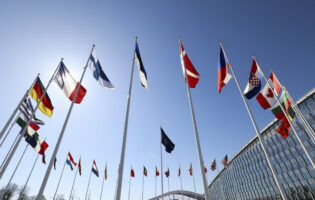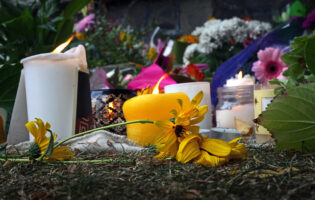Who Can Lead the Change?

Emilia S. Heo
Ritsumeikan Asia Pacific University (Japan)
Dr. Emilia S. Heo is an Associate Professor of International Relations and Peace Studies at Ritsumeikan Asia Pacific University in Japan. She was an AICGS Reconciliation Fellow in 2012. Previously, she was a JSPS Research Fellow at the University of Tokyo with joint affiliation at the United Nations University’s Institute for Sustainability and Peace. Heo’s main interests include interstate reconciliation, regional cooperation, intercultural dialogue, religious diversity and identity politics. She is the author of Reconciling Enemy States in Europe and Asia (Palgrave Macmillan, UK). At AICGS, worked on the impact spiritual values have on reconciliation focusing on religious movements in South Korea and Japan. A graduate of Seoul National University, Dr. Heo specialized first in European Politics at Université Paris VIII, then in International Relations at the Graduate Institute in Geneva, Switzerland. Coupled with a professional background in diplomatic service, she regularly gives lectures at the Korean Parliament.
“Comfort women,” the Dokdo/Takeshima islands, and the Yasukuni shrine are the Achilles’ heel of South Korean-Japanese relations. Recurring for decades, the clashes over history issues this year have taken a serious turn. Despite the ever-flourishing trade relations and socio-cultural interaction, the acrimonious mood between two state leaders seemed to drag the whole region into the so-called “New Cold War” era. Whether their actions and words resulted from political demagogy for their own ambition or a rational calculation for national interest, South Korean president Myung-bak Lee and Japanese prime minister Yoshihiko Noda chose a course that deviates far from reconciliation. South Korean media coverage repeatedly cites the German chancellor Willy Brandt’s “heroic” apologetic gesture in the 1970s and accuses Japan of not having done the same thing. During his official visit to Norway in September 2012, Lee made a speech at the University of Oslo entitled “Korean route and its new horizon,” emphasizing the only way for Asia to reconcile is to follow the European way: true self-reflection and apology.[1] Was Brandt an exceptional man? If he had been the prime minister of Japan, would history have taken a different path?
Is Brandt So Special?
Brandt certainly had a personal quality that made him unique. There are some national leaders, like Nicolas Sarkozy, who argue that religious ideas do not belong in foreign relations. During his official visit to Algeria in 2007, Sarkozy stated that there is no need to apologize for colonial misdeeds: “I’m for a recognition of the facts but not for repentance, which is a religious notion that has no place in relations between states.”[2] He even said that it is absurd to apologize for something in which the current generation was not involved. There are also those like Alcide de Gasperi, Robert Schuman, or Willy Brandt, who shared a strong willingness to connect political actions with moral value. De Gasperi, Italian prime minister from 1945 to 1953, wrote in his book Discorsi Politici that to be Christian in politics implies a profound sense of duty for fraternity and morality. He confessed as well that keeping the same faith inside and outside the Parliament is a constant struggle of his life. Whether it came from his religious faith or personality, Brandt had a visionary leadership based on morality that lasts over generations: “Willy Brandt’s gesture of reconciliation across the borders of old enemies will be interpreted in the spirit it was made. […] He will live on in our history as the great Peace and Reconciliation Chancellor of Germany.”[3]
But this was not all. One of the main reasons his own conviction could lead to a stabilized reconciliatory policy was that there was a consistent national plan that went beyond his personal strategy. Around him, there were many intellectuals and political elites including Egon Bahr, who provided ideas and thoughts to shape a long-term foreign policy such as Ostpolitik. This teamwork transcending any particular political affiliation allowed Germany to develop a coherent national guideline for reconciliation, which is not the case between South Korea and Japan. Having become a democratic country only recently, South Korea still suffers from a severe factionalism while Japan, with its one leading party system, has no room to embrace diverse voices in the Parliament. These fragile domestic political structures thus create additional obstacles to building up a long-term policy, which would not easily get reversed with a new administration.
Not from the Aggressor, but from the Victim Country…
Another element the South Korean press has overlooked regarding Germany’s success of reconciliation is the contribution Polish and German non-state actors had incessantly made to pave the way for societal reconciliation even before the active engagement of state leadership. Brandt himself gave credits to religious actors for their work toward Polish-German reconciliation: “Exchanges between the Churches and their members preceded any dialogue between politicians.”[4] It is of particular importance that the reconciliatory initiative came first not from the aggressor, but from the victim country. Poland’s geopolitical position, sandwiched between two regional powers, drew the nation into the tragic destiny of a weak nation. Russia and Germany (and Prussia) invaded, repressed, and partitioned the Poles over centuries to “extinguish Poland’s national identity.”[5] And yet, it was the Polish Catholic bishops that first appealed to the Germans in 1965 with the message “We forgive and ask for forgiveness.” This is a historic action if we think of the generational hatred deeply anchored in the Polish mindset in the 1950s and 1960s. The Second Vatican Council from 1962 to 1965 served as a locus where Polish and German Catholic bishops could develop their relations and exchange ideas at a time when the official interstate channel was still frozen. The immediate reaction from the German counterpart was lukewarm, but the Bensberger memorandum later in 1968 filled the lack of enthusiasm. Coupled with the 1965 Protestant memorandum, both initiatives demonstrated well to what extent a transnational network with a shared Christian spirit could have an impact upon political change of reconciliation. Some actors were severely accused of being a national traitor and even threatened to death. However, they were convinced that the only way to stabilize a peaceful relationship between Poland and Germany was through reconciliation. Thanks to their close link with the media circle, both memoranda had a strong public resonance, positive and negative, which not only allowed civil society to openly discuss their shared past in public sphere, but also affected the state leadership in the 1970s. Without media, which serves as a channel to connect political elites and the public, it would have been impossible to create a locus where both West German and Polish could work together and transform the public perception. The trio concerto among religious actors, media professionals, and political elites paved the way for the peaceful relationship that Poland and Germany enjoy today.[6]
A Guide for South Korean-Japanese Relations?
Unlike the Polish-German case, South Korean and Japanese religious actors have played a surprisingly small role in bilateral reconciliation. Some argue that the state-centered society is a serious obstacle to active engagement in reconciliation as a social force. Others think that the non-Christian or a-religious culture explains the inherent limit of their role. If these arguments are true to some extent, there is still a need for further reflection. Among others, one of the main differences between the Polish-German and South Korean-Japanese cases comes from the ambivalent connection between religious value and national identity. While religious value played a positive role in bringing lay movements, media elites, and political leaders together in the former case, it played a negative role that divided people in the latter one. Poland, a Catholic country, and Germany, strongly embedded with Protestantism, did not show any conflicting or competitive spirit in working together toward reconciliation in the 1960s and 1970s. Also significant were the extensive connections between Catholics in Germany and Poland and between Protestants in the two countries. Catholics and Protestants did not always share the same opinion on how to resolve the expellees’ issues or to what extent the church should get involved in politics. But in both countries they shared the same conviction that reconciliation is the way for Poland and Germany to restore a stable, peaceful relationship. However, the difficult position Korean Catholics and Protestants, along with Buddhists, had to take against the Shinto nationalism during the Japanese colonial period made it difficult for them to work toward reconciliation after the end of the Second World War.
Conflict of Beliefs, Conflict of Nationalisms
To be Christian in Korean society meant a life struggle in order to keep the faith since Christianity has been marginalized from the dominant Buddhist and Confucian culture. During the colonial period, Japan imposed its state religion, Shinto, on Koreans, which led Korean Christians to be in an even more difficult position. It was not only a conflict of belief between the Christian and Shinto faiths, but also a conflict between two nationalisms. Christians were obliged to go visit the Yasukuni shrine to pay tribute to Imperial Japan, which was a betrayal of their country as well as of their religious faith. Japan went further and asked the Vatican to give its approval that the shrine visit was only a national tribute and not a religious act. Rome accepted Japan’s request, confirming that the shrine visit did not have any religious meaning and thus allowed Christian believers to go worshipping. While Catholics decided to make a compromise since it was the only way to keep a certain level of educational freedom for children, Protestants reacted more violently and refused to go visit the shrine, which led to severe prosecution. What made things worse is that Japan tried to strengthen Buddhism as a counter religious force to Christianity with the aim of oppressing the resistance movement among Christian churches. Religious value thus became not a unifier, but rather a divider of reconciliation. In the aftermath of the Second World War, any attempt by religious groups toward reconciliation, Catholics in particular, was immediately perceived as anti-patriotic in South Korea.
Faint Hope for Reconciliation?
It is only in 1990s that reconciliatory efforts from religious actors became visible. On the Catholic side, in 1996 the Bishops’ conference in Korea and Japan started collaborating and now holds an annual meeting to work for South Korean-Japanese reconciliation. At the commemoration of the 100th anniversary of the conclusion of the Japan-Korea Annexation Treaty in 2010, Jun Ikenaga, Archbishop of Osaka and President of the Catholic Bishops’ conference of Japan, said:
“At this crucial point of history, it is important to earnestly reflect on how the Japanese colonial policies were, including the responsibilities of the Catholic Church. In Peace Message After 60 Years from the End of World War II, the bishops of Japan stated ‘We Japanese are being called to honestly accept our history and share the historic recognition among ourselves.’ To courageously admit one’s failures is not to belittle oneself, but rather to approach the real human figure as Christ desires. In this way, He will break down the dividing wall of enmity and guide us to real reconciliation.”[7]
On the Protestant side, the National Christian Council in Japan, a regional branch of the World Council of Churches based in Geneva, has been very active in protesting the visits by prime ministers to worship at the Yasukuni shrine. In 2006, Seiji Suga, Chairperson of the Council, wrote a letter to Prime Minister Junichiro Koizumi on behalf of the Council:
“We Christians were witness to the sins of our nation as it pursued aggressive warfare and colonialist policies in other Asian nations. We did not protest, but in fact committed the sin of accepting and supporting these policies. Repenting of these sins, we have strived through prayer, verbal protest, and action, to call our nation to admit the wrongs of aggressive warfare and colonialist policies. […] However, Prime Minister Koizumi, you have trampled on our desires, and since August 13, 2001, have continued obstinately to push ahead with yearly visits to worship at Yasukuni Shrine culminating in the visit this year on August 15. We rigorously protest these visits. […] The Prime Minister’s visit to worship at Yasukuni Shrine goes against the peaceful nonaggressive policies of Japan, which have won the trust of foreign countries. These visits break the bonds of reconciliation and goodwill that have been forged over many long years with the people of Asia.”[8]
When it comes to the Buddhist movements, Sou-tou-shu (曹洞宗), the largest Buddhist body in Japan, made a significant gesture of reconciliation in August 2012—the first of this kind. Ichinohe Shogo, the abbot of Unshou Temple in Aomori, said that they decided to set up a memorial stone with a message of apology and repentance at Dong-guk Temple in Gunsan, Korea: “The reason that Japan and Korea have not yet overcome the wall even after forty-seven years of diplomatic normalization is the lack of sincere repentance. I think that this memorial can make a big step towards our future. The only way to resolve colonial issues is through sincere repentance.”[9] Dong-guk Temple was built in 1909 by Sou-tou-shu with the aim of propagation, but it actually served as a military base. Despite hostile reaction and severe threat from right-wing politicians, Ichinohe expressed his lifelong conviction: “Before being a monk of Sou-tou-shu, I am a disciple of Buddha. If I don’t call what is wrong a wrong thing, if I do not apologize for wrong doings, I cannot call myself a monk anymore. Because Buddhism is a practical religion pursuing peace and harmony, the Sou-tou-shu’s message of apology and the memorial itself is very significant.”[10]
The Asian Way
These anecdotes give some fresh hope but they are not powerful enough to contribute to the political change of reconciliation. To make these gestures resonate, there are at least two elements to be seriously taken into consideration. First, the role of mass media in reconciliation must be considered. In The State of Civil Society in Japan, Susan Pharr reveals that there is not only a certain level of antagonism toward religion among journalists, but also timidity among religious groups themselves about the media exposure. Journalists at major daily newspapers rarely cover any news from a religious view and only feature scoops such as priest scandals, sect problem, or corruption of religious institutions, which creates a negative stereotype among population. Because mass media holds influential power to diffuse information, media professionals are called to pay more attention to the positive side of the coin, which then will allow a larger public to develop a more balanced opinion to lead a sound debate. Whether they are ready to capture the sign for reconciliation depends on their personal conviction of moral value.
The second element to be considered is the potential of interreligious dialogue. South Korea is not Poland and Japan is not Germany. It is true that Europe has its root in Christianity. But it is important to note that Christian heritage including Anglicans, Protestants, Catholics, and Orthodox was also the cause for innumerous brutal inter-confessional conflicts throughout European history. It took decades and even centuries to agree on the Augsburg treaty in the late 1990s, the marking point of reconciliation between the Catholic and Protestant churches. In other words, there were conscious and constant efforts from both sides to arrive at reconciliation. If inter-confessional dialogue led to a successful reconciliation in Europe, why can inter-religious dialogue not do the same in Asia? It is certainly a more ambitious goal to achieve. Nonetheless, it will be an unprecedented example of interstate reconciliation if South Korea and Japan manage to create a locus for dialogue bridging Buddhist, Christian, and even Shinto culture. The “Asian” way of reconciliation will in turn serve as a guideline for Europe, facing the current challenge of Turkey’s EU membership and 70 million Muslim citizens.
Dr. Seunghoon Emilia Heo was a Harry and Helen Gray Reconciliation Fellow at AGI in August-September 2012.
[1] “President’s special lecture at the university of Oslo,” Blue House News, 11 September 2012, http://www.president.go.kr/kr/president/news/news_view.php?uno=2031&article_no=656&board_no=P01&search_key=&search_value=&search_cate_code=&order_key1=1&order_key2=1&cur_page_no=1&cur_year=2012&cur_month=
[2] “Sarkozy tells Algeria: No apology for the past,” Reuters, 10 July 2007, http://uk.reuters.com/article/2007/07/10/uk-algeria-france-apology-idUKL1063873720070710
[3] The Nobel Peace Prize 1971, Award Ceremony Speech by the President of the Nobel Committee, Mrs. Aase Lionæs, available online: http://www.nobelprize.org/nobel_prizes/peace/laureates/1971/press.html
[4] Willy Brandt, People and Politics (Boston: Little, Brown, 1978), 182.
[5] Gregory Baum, “The Role of Churches in Polish-German Reconciliation,” in The Reconciliation of Peoples Challenge to the Churches, eds. Gregory Baum and Harold Wells (Maryknoll, NY: Orbis Books, 1997), 129.
[6] Annika Frieberg, “Catholics in Ostpolitik? Networking and Non-State Diplomacy in the Bensberger Memorandum, 1966-1970,” in Searching for a Cultural Diplomacy, eds. Jessica Gienow-Hecht and Mark C. Donfried (Oxford: Berghahn Books, 2010), 109-33.
[7] Comments of Jun Ikenaga, the President of the Catholic Bishops’ Conference of Japan on the occasion of the 2010 Annual Ten Days for Peace, available online: http://www.cbcj.catholic.jp/eng/edoc/100806.htm
[8] Seiji Suga, “Statement of Protest Against Visits to Worship at Yasukuni Shrine,” Japan Christian Activity News (Fall/Winter 2006-2007), 5.
[9] “The Advance Guard for Invading Korea… The Japanese Buddhist Community Shows Repentance for Their Misdeeds,” Chosun-ilbo, 17 August 2012, http://news.chosun.com/site/data/html_dir/2012/08/16/2012081602854.html
[10] “Against the Japanese Right Wing…A Lonely Struggle of a Japanese Monk,” Chosun-ilbo, 7 November 2012, http://news.chosun.com/site/data/html_dir/2012/11/07/2012110700155.html









